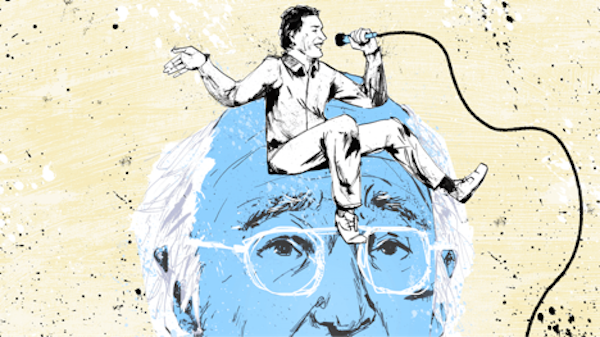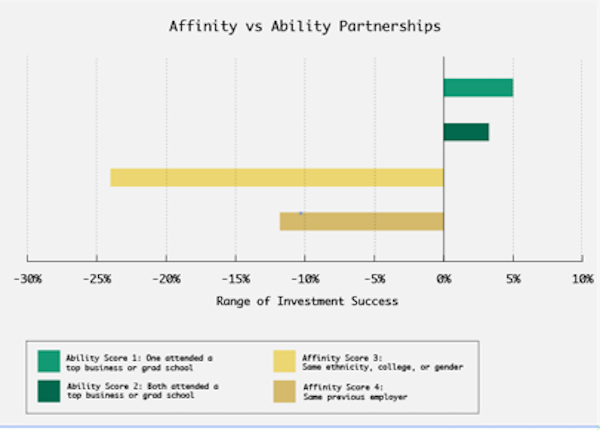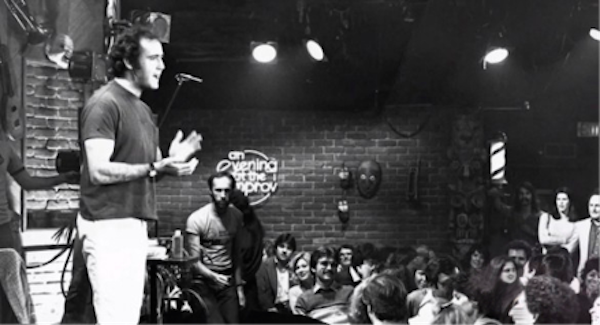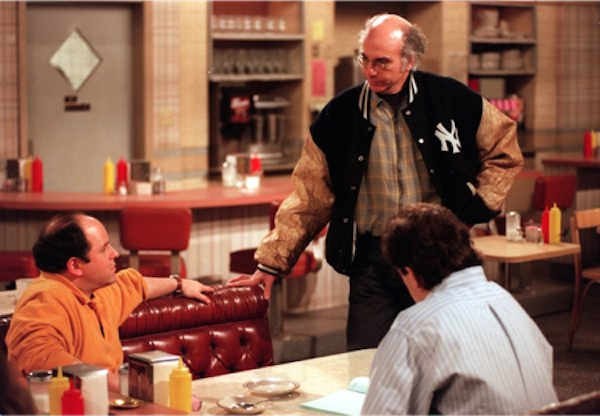
In the first few weeks of the new year, everyone from artists to entrepreneurs will create detailed lists of goals that will supposedly change their outlook for the year. That’s simply what happens around this time of year. But a few people, either by happenstance or on purpose, will stumble onto something far more substantive—their creative partner.
Larry David found himself in such a circumstance in 1988. He was a working comic at the Improv Comedy Club. Telling offbeat jokes and antagonizing the crowd at each turn, he was what insiders call “a comic’s comic.” As he explains, “[it] means I sucked." Nobody would have predicted that this middle-aged comic would become the co-creator of the most successful show of the next decade.
David's style was aggressive. He was unhinged, and his old, worn-down army jacket that accompanied him on stage typified his aura— stodgy and combative. The slightest provocation would throw him into a fury and have him storming off stage. A fellow comic icon, Jerry Lewis, recalled, “Even if someone would whisper, ‘I’ll have another Daiquiri’—literally—he’d storm off. I mean, it was ludicrous.”
His soon-to-be partner, Jerry Seinfeld, couldn’t have been more different. Seinfeld was a natural, smooth and commanding. Comedians would comment about the ease of his on-stage presence, which took years for most to master. He even came up with the convention of the “heckle therapist”. While most comedians in the eighties had learned to take a combative air with audience members who dared interrupted, Seinfeld instead placated them. He recalled that in his early days:
“Instead of fighting them, I would say, ‘You seem so upset, and I know that’s not what you wanted to have happen tonight. Let’s talk about your problem,’ and the audience would find it funny, and it would really discombobulate the heckler too because I wouldn’t go against them, I would take their side.”
The duality that Seinfeld and David exhibited stretches beyond television and the arts. In fields like venture capital, we see the same parallels appear in successful partnerships. A study done by the National Bureau of Economic Research found that there were two types of collaboration in the field: affinity-based relationships with similarities in background, and ability-based relationships determined by prestigious education or experience. Unsurprisingly, partners who were affinity based, whether by being the same ethnicity or by attending the same undergraduate school, showed dramatically worse results over their ability-based counterparts.

Partnerships that were affinity based seemed to suffer from groupthink. Without the contentious decision-making process that arises when different personalities approach a problem together, these people tended to perform worse after their investment. Ability-based partnerships led to performances anywhere from 15–25% better than their affinity-based counterparts. Finding a partner different than oneself is difficult if we’re surrounded by like-minded people and those with similar backgrounds. Fortunately, certain environments can facilitate these coveted partnerships.
For the comedians of the eighties, the Improv was that unusual environment. Everyone from Adam Sandler to Sarah Silverman got their start in this Hell’s Kitchen comedy club. Numerous comedians recall the unfamiliar electricity of the club, the feeling that they were in the midst of a special atmosphere. Places like the Improv where outcasts and creatives can meet are ideal for finding a partner because the balance of community and competition allows people to seek out a partner who would typically be out of their comfort zones.

But this isn’t the only type of environment where partnerships foster—we all can’t be lucky enough to stumble into the defining watering hole of a subculture. When Lars Ulrick, a punkish Danish teenager, was thrown into Orange County, California, he recalled seeing a sea of “five hundred kids in pink Lacoste shirts.” But in this sea was one other musician interested in the same type of New Wave rock that was taking over England—a pesky, quiet kid by the name of James Hetfield. What Hetfield lacked in presence in his day-to-day life, he more than made up for when creating music. Together they would form the band Metallica and sell over 100 million records worldwide.
When two people sense a connection defined by hostility from the mainstream, the same electricity can spark as it would in a more homogenous group. Finding such environments is key for any creative seeking the yin to their yang.
The sense of yin and yang is a trademark of successful partnerships. Unfortunately there’s a tendency for creatives to seek out people exactly like themselves to minimize any confrontation. Seinfeld and David’s similarities started and stopped with their shared vision and sense of observational comedy.
David recalled walking through a grocery store as they came up with the concept of a show and discovering how well their comedy clicked:
"We were in a grocery store and talking about the different products on the shelves. And we were making each other laugh. Then we both realized that this is the kind of dialogue we never really heard on television, or even movies, for that matter. So that was sort of the basis—that was just the way we communicated and the things that we talked about.”
Eccentricities that others would find weird seemed to electrify the duo. But this vision was where the similarities stopped. Personality-wise, they couldn’t have been more opposite. While Jerry was charming, David was cagey; where David was introspective, Seinfeld was the life of the party. A shared vision binds together two disparate people who cannot go in separate directions if they want to create great art. But shared personalities can lead to mediocrity or the death knell of a partnership.

Behind the scenes with Jason Alexander, Larry David and Jerry Seinfeld
For a partnership to reach its pinnacle, like Seinfeld and David’s did, it’s simply not enough to have polarity in a relationship or meet at the right place—those are just perquisites to the coup de grâce. The sense of two people against the world is a recurring theme in highly creative duos. When the Chappelle Show was at the height of its cultural relevancy and getting ready to air its second season, everyone from critics to industry insiders wanted to know about the process behind it: How did Chappelle and company create the skits? Where were those ideas coming from?
Unbeknownst to many, behind the Chappelle Show’s success was not just a brilliant mind but a quiet partner, Neal Brennan. Many of the skits that would become legend were written behind closed doors as Chappelle and Brennan ping-ponged ideas back and forth. But for many in "the business,” this simply wasn’t enough—they needed to know who was the maestro.
Brennan recalled people coming up to him and saying, "‘Seriously, how much of that script did you write?’ Like, you know, ‘Between two good white men, explain to me.’” What seemed like a scene pulled from a skit of the Chappelle Show became reality. Brennan, while often treated in public as riding Chappelle’s coattails, was often credited as the genius behind the showman in private. But Brennan pushed back against this comparison. In fact, he rebuked it. He would later tell Joshua Shenk, author of The Powers of Two, "Yo, man. Everybody just get the fuck out. We’ve got it. Everyone just stay the fuck away. In a vacuum, this shit works.” This theme is a recurring one—the need for the two who have tapped into genius to rebuke the audience. While onlookers will pry and try to reveal the secret of the chemistry, the creatives must continually push back.
Seinfeld was faced with similar circumstances, albeit in a less controversial light. When the show was just beginning to air its pilot, network executives pulled the all-too-typical Hollywood move of rewriting the script. New characters were introduced and a certain hokeyness was added to the plot. David, refusing to do something that went against his character, pulled what would become a signature move—he quit.
This was the quintessential point of no return. At the time, Seinfeld could have found a more experienced writer or a savvier producer, but he doubled down on his partnership and made Larry the executive producer of the show. These types of acts, when a rift appears and a partner is vulnerable, serve as unique opportunities. Partners can strengthen their resolve and continue to push back against the outside world or break from their other half and let the outside world into the process.
It would be years before Seinfeld became a hit. Typically, history has a tendency to wash away the mundane, but for four years Seinfeld and David had an uphill battle in getting their scripts through the network executives. David was even excluded from network meetings because he was simply too volatile. But Seinfeld made sure to keep their scripts intact. By the fourth season, Seinfeld became the epicenter of water-cooler conversation by introducing “yada yada,” "double-dipping a chip," and other Seinfeldisms into popular culture.
The early phases of creative partnerships are its defining moments. It’s where roles congeal, trust is solidified, and dialect is set. Partnerships clearly evolve over time, and unfortunately we see many of the greatest partnerships inevitably falter. But if a creative is faced with writing another long-winded list of goals or seeking their creative partner, the choice is clear.
You can find more of these writings at Habits and Design. Habits and Design looks at self mastery at the intersection of culture and data. Sign up and receive an in-depth step by step guide on how to find your creative partner this year.
